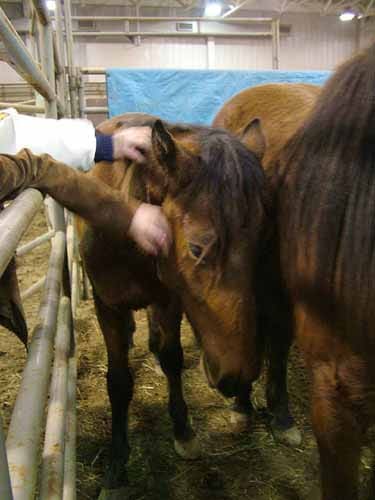
BLM Wild Horse and Burro Auction
February 10-12, 2006
Cooper Arena at Ohio Expo Center, Columbus, Ohio
(To view full-sized photos, click on the small photo links.)
A couple weeks before this event, I spoke with Dr. Al Kane at the BLM booth at the AFA Hoofcare Summit in Cincinnati, OH. Dr. Kane cautioned me that the horses that would be in this auction were not fresh in off the range...not at all...so their hoof form would not be like those mustangs freshly mustered in. This turned out to be a real understatement. Some had been born in captivity, and some had been captured over a year before the sale. Dr. Kane mentioned that the ones who had been born in the wild and captured later in their lives had better hoof form and hoof quality than those that had been born in captivity. Apparently "captivity" for many was being boarded in large pastures full of grass, but these pastures were not on firm, abrasive terrain, which would have been more appropriate for properly maintaining their feet. Some of the older horses had been worked with by prison inmates to get them started on leading, and I have no idea how these horses were housed during their training, or for how long.
I am putting these photos up to show people they should not assume the animals they see at the BLM auctions have ideal hoof form just because they are mustangs. Wild horses do not have automatic, life-long immunity to hoof problems or poor hoof form. Frankly, it was kind of depressing to see the shape their feet were in. While they still were able to get around pretty well--many were agile little guys--many are headed for trouble if they don't start getting better hoof form. I was especially concerned about clubby feet, greatly mismatched toe angles, some dished toes, and some with counter-rotated coffin bones. One horse with both hinds clubbed was twisting his hocks markedly with every step. Over time, this can lead to arthritis. This horse twisting his hocks reminded me of the 2000 Ohio Strasser clinic, where I mentioned to Dr. Strasser than my Max was twisting his hocks a little. She said he was doing this because of heel pain caused by overlaid bars in his hinds. Once I trimmed his bars better, he walked much better...Strasser practically has x-ray vision, she's had so much clinical experience.
Although the rest of the horses had not allegedly been handled, there was one 2 yr. old stud colt I had no trouble petting; he seemed to really enjoy it. There was also just one horse whose mane looked such a consistent length that it must have been pulled, although this horse was not interested in letting anyone touch him. None of the other horses had manes that looked groomed; most had scraggly-looking manes.

This stud colt was in a pen with a bunch of other stud colts. One of older ones was bullying the rest of the colts, and driving them about quite violently. It brought to mind Mark Rashid's observations of 'alpha' leaders in horse herd life who dominate by force and intimidation, rather than becoming leaders through non-violent means--gaining trust and confidence. I was hunched over at one end, quietly taking photographs of their feet. He seemed more interested in me when I had my head lowered, and I would speak to him softly and work up slowly to stroking him in between the mad dashes the bully instigated at intervals. I had hoped to provide a place of peace for him, in whatever limited way I could. During times when he was near where I was at the fence, I eased into petting other spots on him, and scratching itchy spots. He definitely liked all of it. Others watching us remarked, "He must have been messed with before!" Then they started stroking him, too. What a great little guy! He defended himself in a reasonable manner when the bully went after him, but he seemed far more interested in just living peacefully and staying out of trouble. If I had bid on any of them, it would have been on him!
Interestingly, after the bully was moved out of this group and into his own pen by the people working there, another horse took over the role of being a bully...so there still was no peace in the colts' pen. This was by far the rowdiest group, and much more interesting to watch. Things were much quieter in the other pens, where the horses were grouped mostly by sex and age. Burros were grouped separately from horses.
Most of the people I spoke with there were looking to add to the wild horses and burros they already had. They all were really enthusiastic about them, and said their mustangs were the best riding horses they had--more friendly, and level-headed. Many mentioned that most of their mustangs had superior feet. Some were even showing them in dressage, in addition to just ordinary trail riding, competitive trail riding, etc. Many were picking them out just based on coloration. One man wanted any duns he could find, for instance. The friendly little stud colt was too small and plain to interest anybody picking out prospects for their looks, but there were lots of people very impressed with his personality.
The lists posted on the various pens mentioned how old the animals were, when they were captured or if they were born in captivity, etc. I did not get all the lists photographed, but here are the lists I did get:
I apologize for the poor quality of the photos. I did not use flash because I didn't want to scare the horses, or run down my battery. This resulted in a lot of blurry, poor-quality images. To add to my problems, the shutter release button was not always working, either, so I missed a lot of good photos. I'd get all set to take a good picture, and the shutter wouldn't work...and the horses moved again. It was frustrating.
Burros
The burros were older, and had also been in captivity a shorter length of time. Therefore, it was not surprising that they had better hoof form.
Older Mares
Horses already adopted
Young Horses born in Captivity--many 1 year old +/-
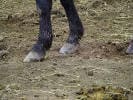
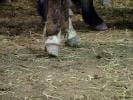
I saw mismatched angles on pairs of feet quite often.
Stud colts--a little older
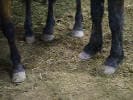
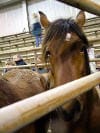
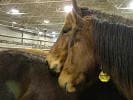
Some had nice-looking feet, but they were in the minority.
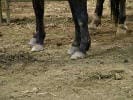
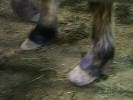

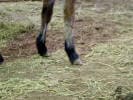
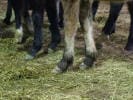
I saw high heels and dished feet, overgrown feet, and mismatched angles on pairs of feet.
Some had hairline slopes higher than 30 degrees, suggesting a counter-rotated coffin bone.
More feet showing problems--not sure which pens they were in, though...
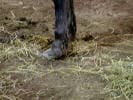
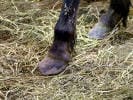
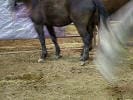
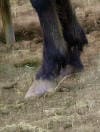
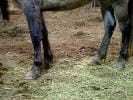
Long feet, some with angles broken back.
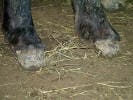
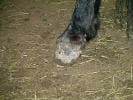
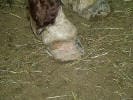
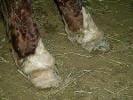
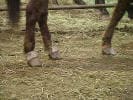
Clubby hinds were common. The red horse with clubby hinds twisted his hocks markedly with every step.
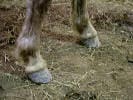
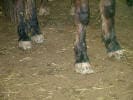
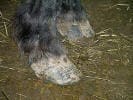
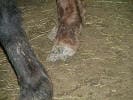
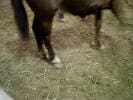
More pairs of mismatched toe angles, clubby hinds...
Back to home page--Table of Contents
Article in sections with "thumbnail" photos for fastest downloads:
1 9 17
2 10 18
3 11 19
4 12 20
5 13 21
6 14 22
7 15 23
8 16 24
NAVICULAR
Article in sections with full-sized photos for print-outs:
1 9 17
2 10 18
3 11 19
4 12 20
5 13 21
6 14 22
7 15 23
8 16 24
NAVICULAR
To Strasser case studies--thumbnail photos for faster downloads
To Strasser case studies--large photos
Please sign my guest book! Photos of my pets My farm
Share Barefoot success stories on this page
Buy or sell used HORSE BOOTS Natural board Barn Listings
Click here to subscribe to naturalhorsetrim
(I moderate this listserv to weed out "fluff.")
Send Email to Gretchen Fathauer, or call (740) 674-4492
Copyright by Gretchen Fathauer, 2015. All rights reserved.